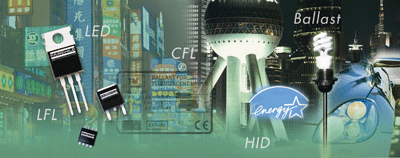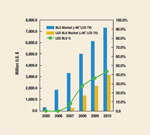Emerging LED backlighting units need driver ICs to achieve better contrast ratio and reduce blurring
BY LUKE HUIYONG CHUNG
Fairchild Semiconductor
San Jose, CA
http://www.fairchildsemi.com
For several years, the relentless competition between liquid-crystal displays (LCDs) and plasma display panels (PDPs) has intensified as new technologies emerge. This competition has resulted in a decline in prices as technology options have increased. With the market near saturation, it appears that the time is right for a big transition, with many saying that the LED backlight unit (BLU) is the next generation of display applications.
LED BLUs are touted for their improved features that are markedly different from cold-cathode fluorescent tube (CCFL) BLUs. LED BLUs offer such advantages as high color gamut, high contrast, no mercury, RoHS compliance, the ability to drive low voltages, and rapid response time. In addition to evaluating the overall merits of LEDs, now is the time for designers to look into power solutions for LED BLUs.

Cost barrier
The high cost of LED BLUs is the only barrier to LEDs entering into a new era of display applications. LED BLUs demonstrate excellent visual performance, and they have been popular as small panels in mobile applications for several years.
Due to steady work by manufacturers to overcome the price barrier, this technology is slowly penetrating mid-size panel applications such as digital photo frames, car navigation systems, notebook PCs, and monitors. In addition, many major television makers are trying to create an LED BLU TV market by introducing new prototypes, although they cannot meet the market demand for low costs.
Driver IC
The larger panel size for LED BLUs requires a driver IC capable of handling the increased requirements. An LED BLU for large-panel TVs must consider following two functionalities (at least) in its BLU circuitlocal dimming to get better contrast ratio and impulsive driving to reduce motion blurring both key benefits of LED BLUs when compared to CCFL BLUs.
The driver IC for LED BLUs performs dynamic backlight control, which can distinguish strong points of LEDs from current other lamps that are necessary, especially for larger panels than small ones. Small panels used in mobile display or digital photo frames do not require local dimming or impulsive driving, nor do they need the outstanding visual quality that larger panel displays require.
To design a dynamic controlling driver IC for LED BLU TVs, a detailed scheme of the LED matrix array is indispensable, due to the number of channels, current level, and voltage level of each channel that are critical in the IC specification. Recently, many TV makers have taken a much more aggressive stance in promoting their new LED BLU TVs.
RGB vs. white LEDs
The emergence of white LEDs is solving the two major issues standing in the way of adopting LED BLUs: the high cost of LED lamps and the uncertainty of the LED matrix design. Although RGB LEDs show much better visual performance (especially in the aspect of color gamut) than white LEDs, studies have shown that human eyes can hardly distinguish the difference between an RGB LED and a white LED because eyes are most sensitive to brightness at a first glance and RGB and white LEDs are almost equal in brightness.
White LEDs are much less expensive than the RGB LEDs so TV manufacturers have used white LEDs to quickly create a new market, even though white LEDs are still expensive compared to CCFLs. The decision on the LED type has accelerated matrix design.
Designers do not have to worry about local dimming in addition to controlling each RGB colors by block. White LEDs reduce many other challenges, such as complexity of the circuit design and unclear current balancing concepts.
Opportunities for power ICs
LED BLUs are creating a new opportunity for power ICs. For instance, several blocks can be merged into one to decrease the number of input voltage for both BLU and system power, or a multichannel balancing function can be added into a dc/dc block with an appropriate current level for each channel.
This means that we can expect more changes in the LED BLU market, not only with MOSFETs but also with driver ICs. The IC market supporting CCFL BLUs is very closed and exclusive to a few IC makers who hold key patents, creating a serious conflict when a new company enters the market.
This is not the case in the LED world, as it is not inverter products but dc/dc products that LED BLUs use for their circuit design. The most important factor for success in this market is how accurately a designer can optimize the driver IC specification to provide a “system-specific IC” for the customers. The LED BLU design concept is still open to a possible revolution to improve the cost structure for each detail in applications with different screen sizes.
Is it the right time?
In terms of the market size, many observers are cautious when they confront the question: Will LED BLUs become the next backlight solution? CCFLs have continuously innovated both in performance and cost. In addition, active-matrix organic light emitting diodes (AMOLEDs) are emerging as the technology that could potentially make LEDs obsolete. However, according to market researcher Displaybank, the LED market is expected to take 40% of the entire BLU market by 2010 (see Fig. 1 ).

Fig. 1. According to Displaybank, the LED market is expected to take 40% of the entire BLU market by 2010.
Many technology obstacles are being resolved by market and technology leaders, and a sudden increase of new LED BLU prototypes implies the market will turn the corner. The LED driver IC market provides opportunities not available to the CCFL inverter market due to CCFL’s dependence on generic dc/dc technologies and not on unique technologies related with patent issues.
Any power solution company that willingly carries out a perfect system application will be considered a leader in this market. Many green thumbs in power solutions can devise appropriate circuitry to provide powerful and accurate balancing ICs.
A design concept that can integrate different kinds of power blocks into one for cost reduction is an ideal solution for manufacturers. Right now, this market is open to any idea, any expertise, any passion. ■
Advertisement
Learn more about Fairchild Semiconductor





